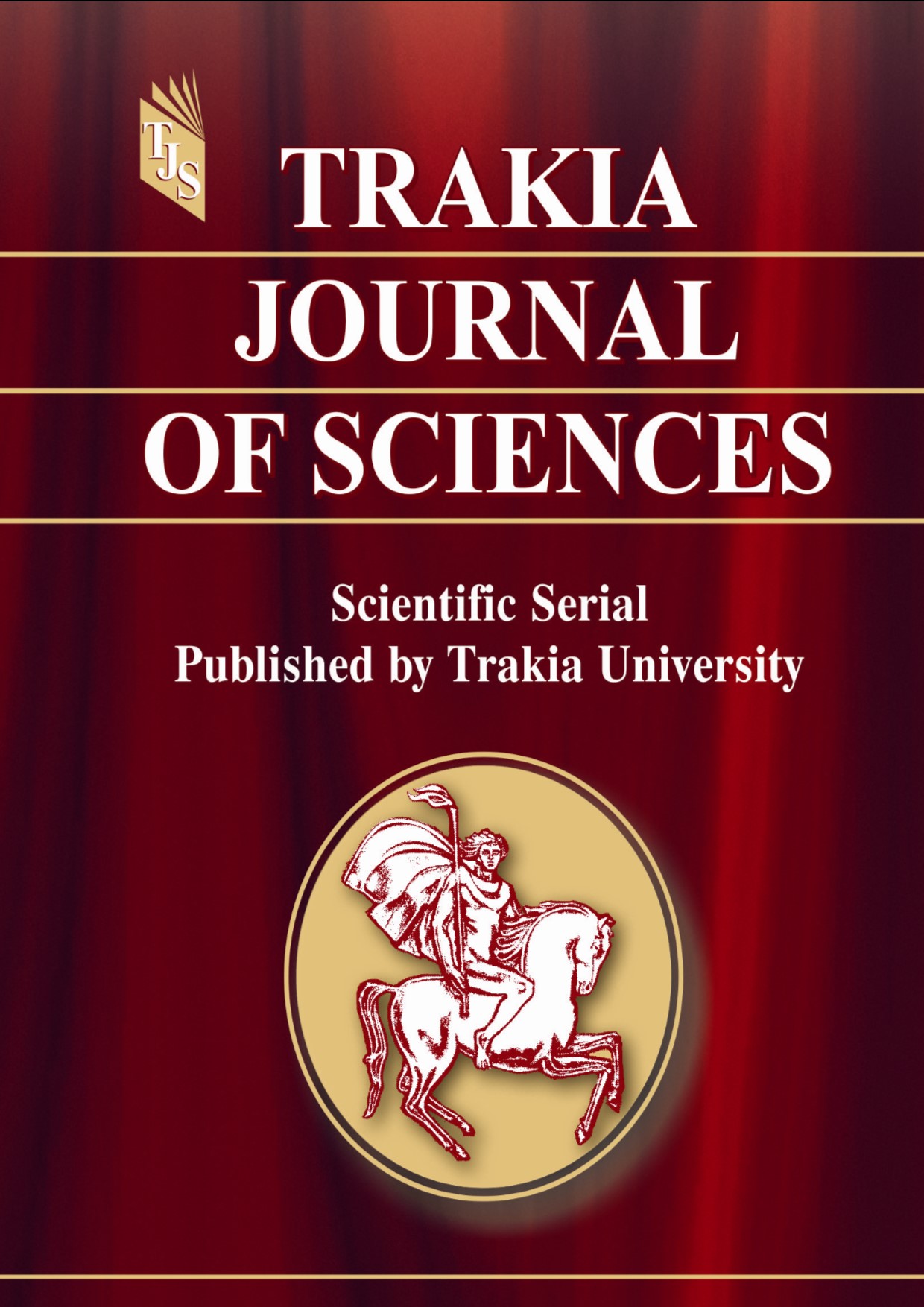THE STAPHYLOCOCCI SPECIES IN THE HUMAN ECOSYSTEM AND AS PATHOGENS OF HEALTHCARE – ASSOCIATED INFECTION
DOI:
https://doi.org/10.15547/tjs.2025.03.012Keywords:
healthcare-associated infections (HAI), nasal staphylococcus carriers, Staphylococcus aureus, coagulase-negative staphylococci (CNS), methicillin-resistant strains (MR)Abstract
The human body, in its evolution, has developed as a distinct, stable ecosystem with established relationships of synergy and commensalism with the microorganisms residing within it. Staphylococci are an integral, structural-defining part of the human microbiome. Their nasal localization becomes a primary reservoir that, in hospital settings, supports the mechanism of spread and poses a risk to susceptible patients. Control of nasal staphylococcal colonization among staff in high-risk departments of general hospitals has shown, in recent years, a predominant presence of methicillin-resistant coagulase-negative staphylococci (CNS-MR), with a high epidemic potential. In the etiological aspect, we observe a decrease in the relative share of Staphylococcus aureus as a causative agent of healthcare-associated infections (HAI) from 73.42% in 2008 to 11.76% in 2022. Conversely, the frequency of infections associated with coagulase-negative staphylococci (CNS) has increased, from 26.58% at the beginning of the observation period to 88.24% in 2022. The proportion of methicillin-resistant coagulase-negative staphylococci (CNS-MR) has also risen as part of all multi-drug-resistant bacterial species isolated from clinical samples. Strains with this type of resistance are primarily found in patients who have undergone surgery, with localization at the surgical site.
In order to ensure the safety of patients treated in the hospital, we share the opinion on the necessity of continuous infection control for both patients and staff, accurate microbiological diagnostics, and the development of an effective strategy for the treatment and prevention of staphylococcal nosocomial infections and carriage
References
Kupenov, N., Toshkov, A., Velianov, D. Ecological aspects of infection, epidemiological and epizootical process, Medicina and Fiscultura, Bulgaria. 1981. (BG)
Neycheff, S. Resident microorganisms of the human body, causing infections, Medicina and Fiscultura, Bulgaria.1984. (BG)
Sakr, A., Brégeon,F., Jean-Louis Mège, J-L., Jean-Marc Rolain,J-M.,Olivier Blin,O. Staphylococcus aureus Nasal Colonization: An Update on Mechanisms, Epidemiology, Risk Factors, and Subsequent Infections, Front Microbiol. 9: 2419. 2018.
Sivaraman K., Venkataraman N., Cole A. M. Staphylococcus aureus nasal carriage and its contributing factors. Future Microbiol. 4: 999–1008. 2009.
Peacock S. J., Justice A., Griffiths D., de Silva G. D. I., Kantzanou M. N., Crook D., et al. Determinants of acquisition and carriage of Staphylococcus aureus in infancy. J. Clin. Microbiol. 41: 5718–5725. 2003.
Maayan-Metzger A., Strauss T., Rubin C., Jaber H., Dulitzky M., Reiss-Mandel A., et al. Clinical evaluation of early acquisition of Staphylococcus aureus carriage by newborns. Int. J. Infect. Dis., 64: 9–14. 2017.
Leshem E., Maayan-Metzger A., Rahav G., Dolitzki M., Kuint J., Roytman Y., et al. Transmission of Staphylococcus aureus from mothers to newborns. Pediatr. Infect. Dis. J., 31: 360–363. 2012.
Wertheim H. F. L., Melles D. C., Vos M. C., van Leeuwen W., van Belkum A., Verbrugh H. A., et al. The role of nasal carriage in Staphylococcus aureus infections. Lancet Infect. Dis., 5: 751–762. 2005.
Fairbrother RW. 1940. Coagulase production as a criterion for the classification of the staphylococci. J. Pathol. Bacteriol. 50:83–88. 1940.
Kaspar U., Kriegeskorte A., Schubert T., Peters G., Rudack C., Pieper D. H., et al. The culturome of the human nose habitats reveals individual bacterial fingerprint patterns. Environ. Microbiol. 18: 2130–2142. 2016.
Yan M., Pamp S. J., Fukuyama J., Hwang P. H., Cho D.-Y., Holmes S., et al. Nasal microenvironments and interspecific interactions influence nasal microbiota complexity and S. aureus carriage. Cell Host Microbe. 14: 631–640. 2013.
Mongodin, E., Bajolet, O., Cutrona, J. et al. Fibronectin-bindingproteins of Staphylococcus aureus are involved in adherence to human airway epitelium. Infect. Immun., 70: 620-630. 2002.
Nashev, D., Toshkova, K. et al. Distribution of virulence genes of Staphylococcus aureus isolated from stable nasal carriers., FEMS Microbiol Lett. 233: 45-52. 2004. (BG)
Navarre, W., Schneewind, O. Surface proteins of Gram /+/ bacteria and mechanisms of their targeting to the cell wall envelope. Microbiol. Mol. Biol. Rev. 63: 174-229. 1999.
Patti, J.M., Jonsson, H. Guss, B. et al. Molecural characterization and expression of a gene encoding a Staphylococcus aureus collagen adhesin. J.Biol.Chem. 267, 47: 66-4772. 1992.
Eckhart L., Lippens S., Tschachler E., Declercq W. Cell death by cornification. Biochim. and Biophys. Acta Molecular Cell Research. Vol.1833. Iss.12., 3471–3480. 2013.
Burian M., Wolz C., Goerke C. Regulatory adaptation of Staphylococcus aureus during nasal colonization of humans. PLoS One. April 6, 2010.
Weidenmaier C., Kokai-Kun J. F., Kristian S. A., Chanturiya T., Kalbacher H., Gross M., et al. Role of teichoic acids in Staphylococcus aureus nasal colonization, a major risk factor in nosocomial infections. Nat. Med. 10: 243–245. 2004.
Wertheim H. F. L., Walsh E., Choudhurry R., Melles D. C., Boelens H. A. M., Miajlovic H., et al. Key role for clumping factor B in Staphylococcus aureus nasal colonization of humans. PLoS Med. Jan. 15, 5, (1): e 17. 2008.
Peschel A., Sahl H.-G. The co-evolution of host cationic antimicrobial peptides and microbial resistance. Nat. Rev. Microbiol. 4: 529–536. 2006.
Kotpal R., S K. P., Bhalla P., Dewan R., Kaur R. Incidence and risk factors of nasal carriage of Staphylococcus aureus in HIV-infected individuals in comparison to HIV-uninfected individuals: a case–control study. J.Int.Assoc.Provid. AIDS Care. 15: 141–147. 2016.
Hanssen A.-M., Kindlund B., Stenklev N. C., Furberg A.-S., Fismen S., Olsen R. S., et al. Localization of Staphylococcus aureus in tissue from the nasal vestibule in healthy carriers. BMC Microbiol. 17: Article number: 89. 2017.
Clement S., Vaudaux P., Francois P., Schrenzel J., Huggler E., Kampf S., et al. Evidence of an intracellular reservoir in the nasal mucosa of patients with recurrent Staphylococcus aureus rhinosinusitis. J.Infect.Dis. 192: 1023–1028. 2005.
Hayes S. M., Howlin R., Johnston D. A., Webb J. S., Clarke S. C., Stoodley P., et al. Intracellular residency of Staphylococcus aureus within mast cells in nasal polyps: a novel observation. J. Allergy Clin. Immunol. 135: 1648–1651. 2015.
Ou J., Bassiouni A., Drilling A., Psaltis A. J., Vreugde S., Wormald P. J. The persistence of intracellular Staphylococcus aureus in the sinuses: a longitudinal study. Rhinol. J. 55: 305–311. 2017.
Rigaill J., Morgene M. F., Gavid M., Lelonge Y., He Z., Carricajo A., et al. Intracellular activity of antimicrobial compounds used for Staphylococcus aureus nasal decolonization. J. Antimicrob. Chemother. 73 (11): 3044-3048. 2018.
Lehar S. M., Pillow T., Xu M., Staben L., Kajihara K. K., Vandlen R., et al. Novel antibody–antibiotic conjugate eliminates intracellular S. aureus. Nature. 527: 323–328. 2015.
Hamilton-Miller JM, Iliffe A. Antimicrobial resistance in coagulase- negative staphylococci. J. Med. Microbiol. 19:217–226. 1985.
Guggenheim M, Zbinden R, Handschin AE, Gohritz A, Altintas MA, Giovanoli P. Changes in bacterial isolates from burn wounds and their antibiograms: a 20-year study (1986-2005). Burns. 35:553–560. 2009.
Mody, L., Kauffman, C.A., McNeil, S.A. et al. Mupirocin-based decolonization of Staphylococcus aureus carriers in residents of 2 long-term care facilities: a randomized, double-blind, placebo-controlled trial, Clin. Infect. Dis. 37, 1467-74. 2003.
Perl, T.M., Cullen, J.J., Wenzel, R.P.q et al. Intanasal mupirocin to prevent postoperative St. aureus infections., N.Engl.J.Med. 346:1871-77. 2002.
Patel JB, Gorwitz RJ, Jernigan JA. Mupirocin resistance. Clin Infect Dis., 49:935–41. 2009.
Kaur DC, Narayan PA. Mupirocin resistance in nasal carriage of Staphylococcus aureus among healthcare workers of a tertiary care rural hospital. Ind J Crit Care Med. 18:716–21. 2014.
Rahman M, Connolly S, Noble WC, Cookson BD, Phillips I. Diversity of staphylococci exhibiting high-level resistance to mupirocin. J Med. Microbiol. 33:97–100. 1990.
S. Connolly1, W. C. Noble1, I. Phillips1 Mupirocin resistance in coagulase-negative staphylococci, J. of Medical Microbiology. Vol.39, Iss.6, 450-453. 1993.
G. Peters, G. Pulverer, Pathogenesis and management of Staphylococcus epidermidis ‘plastic’ foreign body infections, J. Antimicrob. Chemother. 14 (Suppl. D), 67-71. 1984.
G O'Toole, H.B Kaplan, R Kolter, Biofilm formation as microbial development, Annu. Rev. Microbiol. 54: 49-79. 2000.
Gottenbos, B., van der Mei, H.C., Busscher, H.J. Initial adhesion and surface growth of Staphylococcusepidermidis and Pseudomonas aeruginosa on biomedical polymers, J. Biomed. Mater. Res., 50: 208-214. 2000.
S. Kozitskaya, M.E. Olson, P.D. Fey, W. Witte, K. Ohlsen, W. Ziebuhr, Clonal analysis of Staphylococcus epidermidis isolates carrying or lacking biofilm-mediating genes by multilocus sequence typing, J. Clin. Microbiol. 43: 4751- 4757.2005.
Karsten Becker , Christine Heilmann , Georg Peters. Coagulase-Negative Staphylococci, Clin Microbiol Rev,. 27(4):870–926. 2014.
Perl T. M., Cullen J. J., Wenzel R. P., Zimmerman M. B., Pfaller M. A., Sheppard D., et al. Intranasal mupirocin to prevent postoperative Staphylococcus aureus infections. N. Engl. J. Med. 346: 1871–1877. 2002.
Chen A. F., Heyl A. E., Xu P. Z., Rao N., Klatt B. A. Preoperative decolonization effective at reducing staphylococcal colonization in total joint arthroplasty patients. J. Arthroplasty. 28: 18–20. 2013.
Weiser M. C., Moucha C. S. The current state of screening and decolonization for the prevention of Staphylococcus aureus surgical site infection after total hip and knee arthroplasty. J. Bone Joint Surg. Am. 97: 1449–1458. 2015.
Yano M., Doki Y., Inoue M., Tsujinaka T., Shiozaki H., Monden M. Preoperative intranasal mupirocin ointment significantly reduces postoperative infection with Staphylococcus aureus in patients undergoing upper gastrointestinal surgery. Surg. Today 30: 16–21. 2000.
Cuong Vuong , Michael Otto. Staphylococcus epidermidis infections. Microbes Infect,. (4):481-9. 2002.
Tacconelli, E.,Tumbarello,M., Pittiruti, M., Leone, F., Lucia, M.B., Cauda,R., Ortona, L. Central venous catheter-related sepsis in a cohort of 366 hospitalised patients. Eur. J. Clin. Microbiol. Infect. Dis., 16: 203-209. 1997.
Karsten Becker , Gabriele Bierbaum , Christof von Eiff , Susanne Engelmann , Friedrich Götz , Jörg Hacker , Michael Hecker, Georg Peters , Ralf Rosenstein , Wilma Ziebuhr. Understanding the physiology and adaptation of staphylococci: A post-genomic approach, International Journal of Medical Microbiology. Vol.297, Iss.7–8, 483-501. 2007.
C. vonEiff, B. Jansen, W. Kohnen, K. Becker, Infections associated with medical devices: pathogenesis, management and prophylaxis, Drugs, 65:179-214. 2005.
C. Vuong, C. Gerke, G.A. Somerville, E.R. Fischer, M. Otto, Quorum-sensing control of biofilm factors in Staphylococcus epidermidis. J. Infect. Dis., 188: 706-18. 2003.

Downloads
Published
Issue
Section
License

This work is licensed under a Creative Commons Attribution-NonCommercial 4.0 International License.


